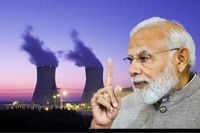On November 27, 2025, Prime Minister Narendra Modi set India on a bold new path by announcing that the country will open its tightly controlled nuclear energy sector to private companies. The move, made public during the virtual inauguration of Skyroot Aerospace’s Infinity Campus in Hyderabad, marks a seismic shift in India’s approach to energy, innovation, and national strategy. For over six decades, the nuclear sector has remained a government monopoly, closed to private capital and initiative. Now, with the planned introduction of the Atomic Energy Bill, 2025, India is poised to rewrite that script.
"We are moving towards opening the nuclear sector as well. We are laying the foundation for a strong role for the private sector in this field too," Modi declared, as reported by PTI. He went on to explain, "This will create opportunities in small modular reactors, advanced reactors and nuclear innovation. This reform will give new strength to our energy security and technological leadership." The announcement was anything but routine. As The Times of India noted, it was a structural shift—one that redefines how India views power, technology, risk, and its national ambitions.
The government’s goal is nothing short of audacious: to scale India’s nuclear power capacity from the current 8.8 GW to a staggering 100 GW by 2047. This vision, according to PTI, is foundational to India’s dream of becoming a developed nation—what Modi often refers to as "Viksit Bharat." Achieving this target will require a transformation in how nuclear energy is generated, managed, and innovated upon, and the inclusion of private enterprises is seen as a vital piece of that puzzle.
The legal groundwork for this transition is already being laid. The Atomic Energy Bill, 2025, is slated for introduction in the Winter Session of Parliament, which begins December 1. The Bill aims to dismantle the 60-year-old state monopoly established by the Atomic Energy Act of 1962, which has so far barred private companies—and even state governments—from participating in nuclear power generation. Only government-owned entities have been permitted to set up and operate nuclear power plants, with all authority centralized under the Department of Atomic Energy.
This isn’t the first signal of reform. Back in February 2025, Finance Minister Nirmala Sitharaman announced plans to amend India’s nuclear liability law, indicating a broader effort to modernize the sector. The government also intends to amend the Civil Liability for Nuclear Damage (CLND) Act, 2010, to address private investors’ concerns about legal and financial uncertainty. As The Times of India reported, "No serious private investor will touch nuclear projects if liability laws are vague, punitive, or politically weaponisable." The government’s willingness to clarify and streamline these laws is a clear signal that it means business.
But why now? The answer lies in India’s evolving energy needs and the limitations of its current energy mix. Coal remains the backbone of Indian electricity, but it comes with environmental costs and growing global criticism. Solar and wind are expanding rapidly, yet they are intermittent and require vast tracts of land. Hydropower is geographically constrained, and oil and gas are largely imported, leaving India exposed to global price shocks and geopolitical pressures—think of the recent tensions over Russian oil purchases, as highlighted by The Times of India.
Nuclear power, on the other hand, offers clean, reliable, and scalable base-load energy. Unlike renewables, it doesn’t depend on the weather, and unlike fossil fuels, it doesn’t tie India’s fortunes to foreign suppliers. This is about more than just electricity—it’s about sovereignty. As The Times of India put it, "Countries that control reliable, scalable energy are not just richer; they are harder to threaten, harder to sanction, harder to coerce." By expanding its domestic nuclear capacity, India reduces its dependence on imported hydrocarbons, Western-controlled climate financing, and foreign technology chokepoints.
Modi’s announcement also draws inspiration from another sector that has undergone a similar transformation: space. For decades, India’s space program was the exclusive domain of the Indian Space Research Organisation (ISRO). While ISRO achieved remarkable feats, progress was often hampered by bureaucratic inertia. The opening of the space sector to private players changed the game. Startups like Skyroot and Agnikul injected agility, risk-taking, and private capital, turning India into a commercial space hub. Modi made the connection explicit: "The nation is witnessing an unprecedented opportunity in the space sector today. The private sector is taking great strides in India's space sector. Skyroot's Infinity Campus is a reflection of new thinking, innovation and youth power," he said. If private participation could democratize and accelerate space innovation, why not nuclear?
The focus areas for the nuclear sector’s opening are telling. The government plans to develop Bharat Small Reactors, small modular reactors (SMRs), and advanced next-generation reactor technologies. SMRs, in particular, are seen as revolutionary—they require less land, involve lower upfront capital, can be deployed faster, and are inherently safer due to modern passive cooling and containment systems. For a densely populated country like India, these attributes are not just attractive—they are essential.
Private participation in the nuclear sector is expected to do more than just bring in money. It promises competition, speed, accountability, manufacturing depth, and integration with global innovation ecosystems. According to The Times of India, "Opening the nuclear sector can create a massive secondary ecosystem. It means thousands of high-skilled engineering jobs, domestic manufacturing of specialized components, new research institutions, advanced material science development, and export possibilities." In other words, a mature nuclear industrial base doesn’t just produce electricity—it produces scientific capacity, strategic depth, and technological prestige.
This move is not an isolated policy tweak. It fits into a broader pattern of reforms under Modi’s leadership: the semiconductor push, defense indigenization, space privatization, digital public infrastructure, and now nuclear. What ties these together is the pursuit of sovereignty through capability. As The Times of India observed, "By 2047, when India marks 100 years of Independence, the countries that will dominate the world won’t just be the richest. They will be the ones with secure energy, secure chips, secure data, and secure defense production. Nuclear reform is one pillar of that architecture."
Crucially, the reform is not about privatizing nuclear weapons or handing over strategic assets to corporations. The focus is strictly on civilian nuclear power—energy generation, reactor development, supply chains, engineering, research, and innovation—under strict regulatory supervision. The state’s role will shift from monopolistic controller to strategic regulator and enabler, ensuring safety and sovereignty while unleashing the creative and competitive energies of the private sector.
With the Atomic Energy Bill, 2025 on the horizon and a clear vision for the future, India stands at the threshold of a new era in nuclear energy. The real risk, as The Times of India put it, was not in reforming the sector, but in remaining "trapped in a system built for a different century, with different ambitions, and much lower expectations." With this move, India is choosing strength, resilience, and a future powered by its own innovation.




